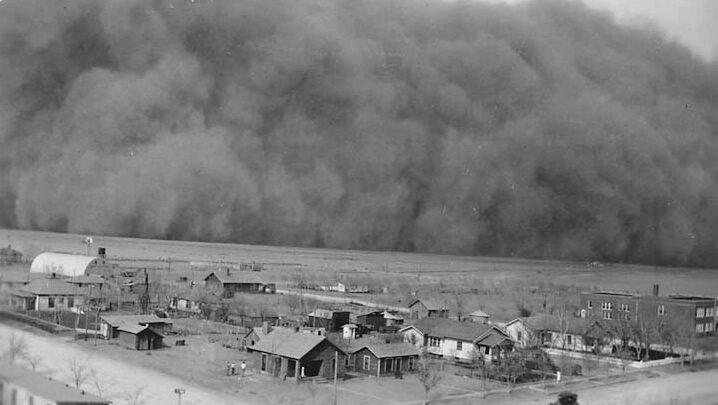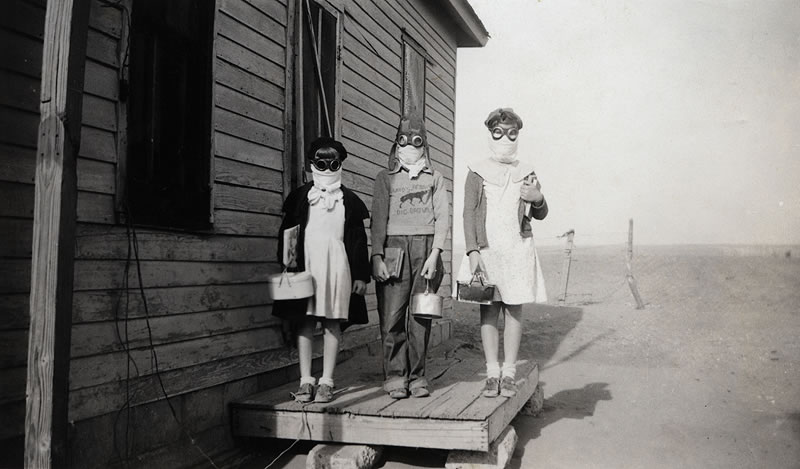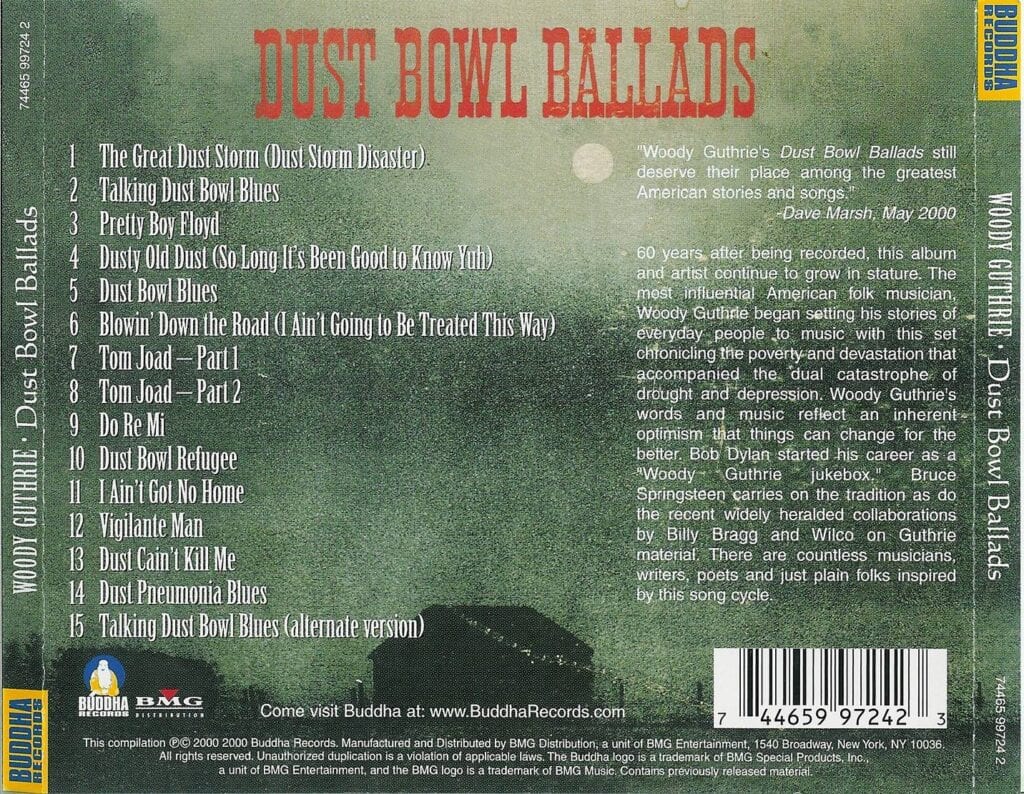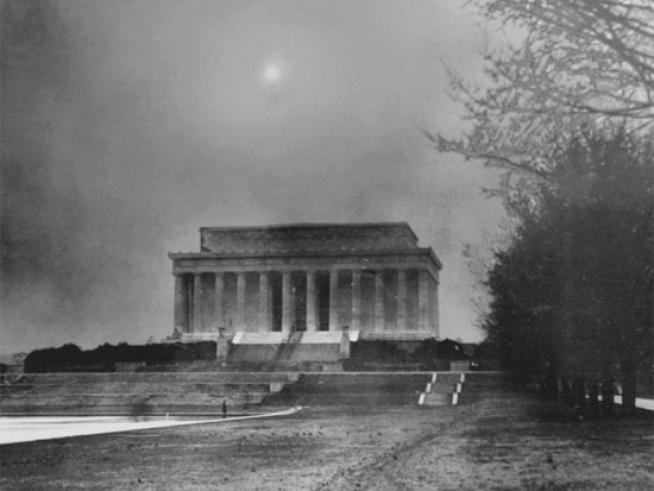What is a Black Blizzard? Is it:
- A snowfall that is black because of air pollution (primarily coal dust).
- A snowfall so massive the sun is blacked out.
- A swarm of locust or grasshoppers so thick they block out the sun.
- An intense dust storm, especially in the dust-bowl area of the U.S.
- A chocolate ice cream treat from Dairy Queen
During the decade long drought in the 1930s, the soil turned into dust in the Great Plains. The dust was then blown by prevailing winds in huge clouds that often blackened the sky. In 1932 there were 14 dust storms. In 1933 there were 38 such storms. These dust storms were named black blizzards or black rollers. There is an excellent 4-minute video about Black Blizzards at https://www.youtube.com/watch?v=Ep7-7x2sp8Y.

Figure 1. A Black Blizzard approaching Rolla, KS on May 6, 1935.
Image from the FDR Digital Archives.
One notable black blizzard occurred on May 11, 1934. This storm was two miles high and traveled 2,000 miles to the East Coast, blotting out monuments such as the Statue of Liberty and the U.S. Capitol. According to The New York Times, dust “lodged itself in the eyes and throats of weeping and coughing New Yorkers.” Three hundred miles out into the Atlantic Ocean sailors aboard ships reported dust ½ inch thick on the decks of their ships. This particular storm was estimated to have displaced 300 million tons of topsoil.

Figure 2: New York Times, May 12, 1934.
What Was The Dust Bowl?
The Dust Bowl describes an “area” and an “era”. The dust bowl covered 100 million acres, primarily in Kansas, Oklahoma, Texas, New Mexico, and Colorado but impacted other surrounding states. In this area of the United States, there was a prolonged drought starting in 1930 and then the winds started to blow and continued to blow until the 1940s. Breathing, eating, and walking was no longer simple. Children wore dust masks to and from school, women hung wet sheets over windows in a fruitless attempt to stop the dust, and farmers watched helplessly as their crops blew away. The Dust Bowl was the name given to the Great Plains region devastated by drought in 1930s depression-ridden America.

Figure 3. Map of Dust Bowl states
Dust storms, at first considered freaks of nature, became commonplace. Static charges in the air shorted-out automobiles on the road. Many drivers attached a chain to the car’s axle and drug it on the road in an effort to ground the car. Huge drifts of dirt buried pastures and barnyards, piled up in front of homesteaders’ doors, came in through window cracks and sifted down from ceilings.

Figure 4. Drifting soil near Dallas, South Dakota
During this era around 7,000 people, men, women, and children lost their lives to “dust pneumonia” in the dust bowl states At least 250,000 people fled the plains to head to urban areas or move out west. These folks just abandoned their farms. Timothy Egan in his book The Worst Hard Time states that cattle went blind and suffocated. When farmers cut them open, they found stomachs stuffed with fine sand. The instinctive act of hugging a loved one or shaking someone’s hand could knock two people down because of the strong static electricity created by the dust storms.

Figure 5. Children heading to school during the dust bowl era. Notice the lunch pails, masks and goggles, and the dusty haze in the air.
A number of factors contributed to creating the dust bowl. During World War I American farmers were called on to grow more wheat and other crops to aid in the war effort. Being patriotic, the farmers responded. According to the USDA Agricultural Census, in 1910, before WWI, American farmers produced 625 million bushels of wheat on 45,793,000 acres and received 91 cents a bushel. At the end of WWI, farmers produced 843 million bushels of wheat on 62,358,000 acres and received $1.83 a bushel (1920). However, European agriculture recovered after the war and the demand and price for wheat dropped all during the 1920s. By 1930 wheat was selling for only 67 cents a bushel. To compensate for the lost income farmers plowed up every acre they could to increase their wheat production.
During this era, the recommended practice was “deep plowing”. Farmers would plow up to 20 inches deep and then go over the plowed land with a harrow to break up the clods and create a fine seedbed. The theory was deep plowing would aid in water retention. But the problem was the rain didn’t come. During the 1930s there was a prolonged drought. With the native grasses plowed under and crops not growing because of lack of rain, the topsoil blew away with the winds.
Livestock overgrazed the land. There were herds (yes, herds) of jackrabbits eating whatever vegetation remained. And at times there were great swarms of grasshoppers who would even try to eat wooden fence posts and tool handles. The 3 1/2 minute video about Dust Bowl Pests is worth watching. As if all of this was not bad enough banks were going under and the economy was decimated because of the great depression. Unemployment reached 25 percent. Teachers in this area were paid with IOU script (which was basically worthless).
John Steinback’s epic novel, The Grapes of Wrath, follows the Joads, tenant farmers from Oklahoma, who travel to California to escape the dust bowl. The book won a Pulitzer Prize for fiction and was made into a movie in 1940. If you haven’t read this book, you might consider doing so.

Figure 6. The Grapes of Wrath
Because so many people were leaving the great plains heading to California, signs were posted in California telling the out-of-staters there were no jobs in California and to stay out.

Figure 7. A sign in California during the dust bowl era.
American folk singer, Woody Guthrie, debuted his first music album in 1940. It was titled Dust Bowl Ballads and was semi-biographical since he had lived in Oklahoma during the dust bowl and left the state looking for work (eventually ending up in California). The “Dust Bowl Blues” portrays what life was like in the dust bowl era. The 14 other songs including Dust Pneumonia Blues (even though he pronounces it pneumony) are worth listening to. The song “The Great Dust Storm” is about Black Sunday (see more below). There are two songs about Tom Joad (from the Grapes of Wrath). Most of these songs can be found on YouTube.

Figure 8. Dust Bowl Ballads
The Federal Government Responds
While Congress twiddled their thumbs in 1933 regarding the dust bowl and soil erosion the newly elected President Franklin D. Roosevelt took action. During his first 100 days in office, his administration took action to conserve soil and restore the ecological balance of the nation. A “Soil Erosion Service” was established within the Department of the Interior in August of 1933 with temporary funding that was to last for two years.
The Director of the newly created Soil Erosion Service was Hugh Hammond Bennett (he grew up on a cotton farm in North Carolina and had degrees in geology and chemistry). He had worked in the Bureau of Soils within the United States Department of Agriculture since 1903 conducting soil surveys. While surveying and classifying soil he became alarmed that the erosion he was observing not only had a negative impact on the individual farmer but posed a threat to the rural economy. He authored numerous articles in the popular press (including The Agricultural Education Magazine) and in scientific journals about the threats of soil erosion. His most influential work was a co-authored USDA publication Soil Erosion: A National Menace, in 1928. This publication along with his vast experience and education suited him well to be the director of the newly created Soil Erosion Service.
The agency worked with farmers to demonstrate soil conservation methods in watershed-based demonstrations. However, Bennett wanted the work to have a firmer legislative foundation (the Soil Erosion Service was to run out of temporary funding in June of 1935) and he advocated Congress for federal legislation specifically addressing soil erosion.
On March 21, 1935, Hugh testified in a Senate hearing that several years of “black blizzards” and severe soil erosion showed that the nation was in need of more efficient soil conservation methods. Bennett had been alerted by a colleague in the Midwest that a dust cloud would soon arrive in Washington. So, Bennet made sure windows were left open with water glasses nearby (Congress was not yet air-conditioned). The arrival of the dust storm filled the halls of Congress with dust and caked the water glasses with mud. Mr. Bennett only needed to point out the window to the evidence supporting his position, and say, “This, gentlemen, is what I’ve been talking about.” However, it would take a little longer before Congress would finally take action on soil conservation legislation.

Figure 9. The Lincoln Memorial in Washington, DC during a dust storm.
If Congress needed more evidence that a soil conservation bill was needed, they got it–in the form of “Black Sunday.” (Follow this link to 1 ½ minute video about Black Sunday). April 14, 1935 started out as a nice spring day on the Plains. However, a large dust storm came in from the north and the temperatures dropped 40 degrees. The cloud of dust rose 600 feet into the air and was traveling at 50-60 miles per hour. People scurried to find cover. When the storm hit, it was total darkness. You could not see your hand in front of your face. Many people in the plains thought the world was ending. This storm made headlines nationally. Congress was finally convinced that action was needed. Less than two weeks later (April 27. 1935) President Roosevelt was signing the Soil Conservation Act (PL 74-46) into law This act created the Soil Conservation Service within the USDA.

Figure 10. The Black Sunday storm in Ulysses, KS. April 14, 1935. Photo from Historic Adobe Museum, Ulysses, KS.
The Soil Conservation Service
PL 74-46 established the Soil Conservation Service to combat soil erosion and “to preserve natural resources, control floods, prevent impairment of reservoirs, and maintain the navigability of rivers and harbors, protect public health, public lands and relieve unemployment.” While the act appropriated no money upfront, it left open the option to fund projects with “such sums as Congress may from time to time determine to be necessary.” A year later, Congress passed the Soil Conservation and Domestic Allotment Act which rewarded farmers who planted grasses and legumes to support the soil, rather than commercial crops that exhausted its nutrients.
The national Soil Conservation Service set up a number of large-scale demonstration projects around the country. Although these projects were successful, this approach was not far-reaching enough. It was costly and slow in achieving the desired results. The main problem was that the projects lacked grass-roots support and participation.
It was recognized that a local organization was necessary through which conservation could be accomplished. On June 5, 1935, the Secretary of Agriculture’s Committee on Soil Conservation recommended that “all erosion control work on private lands, including new demonstration projects, would be undertaken by SCS only through legally constituted Soil Conservation Associations. From this recommendation, the soil conservation district was born. In February 1937, a model Soil Conservation District Law was developed for consideration by each of the states. Along with a letter from President Roosevelt, this model enabling act was sent to each of the state governors, suggesting that farmers and ranchers be granted the authority to establish districts specifically for the conservation of soil and water resources. The states responded, but with varying degrees of speed. Twenty-two states passed enabling legislation within the same year. Ultimately all 50 states, plus Puerto Rico and the Virgin Islands, adopted the enabling laws. (Tran & Chuang, 1996).
The federal Soil Conservation Service would then work with and through the local Soil Conservation Districts. Today, there are over 3,000 Soil Conservation Districts across America (but they go by various names). In North Carolina, each soil conservation district is governed by a five-member board of supervisors. Three supervisors are elected on the general ballot as non-partisan candidates during the regular election of county officers. Most states have similar provisions. So, if you wonder why soil conservation positions are on the ballot, now you know why.
In 1994 the name was changed to the Natural Resources Conservation Service to reflect its broader mission. It is a relatively small agency, currently comprising about 12,000 employees. Its current mission is to improve, protect, and conserve natural resources on private lands through a cooperative partnership with state and local agencies (the Soil Conservation Districts). While its primary focus has been agricultural lands, it has made many technical contributions to soil surveying, classification and water quality improvement.
Concluding Remarks
In the 1938 USDA Yearbook of Agriculture Charles Kellogg wrote, “Essentially, all life depends upon the soil … There can be no life without soil.” How true. I realize that teaching about soil is not always exciting and glamorous but we should try to make it interesting.
During my sophomore and junior summers while in college, I was an intern for the Soil Conservation Service. I loved the work and the people. When I graduated from college, I was offered a position with the SCS as a soil conservationist in West Texas. I was torn between accepting that position and becoming an agriculture teacher. However, my love for teaching won out and I chose that route. I don’t think I made a mistake. I could still advocate for soil conservation as an educator.
For your own professional development, I would strongly encourage you to get a copy of The Worst Hard Time by Timothy Egan. It describes the dust bowl era through the eyes of numerous individuals who experienced it. It is sobering but educational. I downloaded the Kindle edition through Amazon for $2.99. It was well worth it. And I received the Audible version of it for free. On a recent trip, I listened to the entire book.
The Soil Conservation Service played a major role in restoring agricultural land back to being productive through the use of soil conservation practices. The two photos below show a before and after of the same land. We owe a huge debt of gratitude to the federal legislation and visionaries who promoted soil conservation, especially Hugh Hammond Bennett, the father of soil conservation.


Figure 11. Images of the same land before and after the application of soil conservation practices.
Teaching Suggestions
Have your students do a Google search for images from the Dust Bowl era. Have them select three images and tell what they depict.
Invite a representative of the Natural Resources Conservation Service to speak to a class or FFA meeting about the work of a soil conservationist.
Have students go to the Wessels Living History Farm web site and explore the Farming in the 1930s tabs. Have them view some of the interviews of farmers from the Dust Bowl era and explain what they learned from watching the videos. There are even some remembrances about electricity that tie into last week’s Footnote. The URL is https://livinghistoryfarm.org/farminginthe30s/water_02.html#:~:text=In%201932%2C%2014%20dust%20storms,that%20Sunday%20was%20the%20worst.
I have no qualms about requiring agriculture students to conduct research and write papers. You could assign a 1-2 page research assignment about the impact of the dust bowl on agriculture and the lessons to be learned.
Following are some noteworthy videos about the Dust Bowl you might show in class:
- https://www.youtube.com/watch?v=7xfiwICl7SI – Four-minute video about Black Sunday.
- https://www.youtube.com/watch?v=n-rBhbkvtm0 – Brief 4 minute film about the history of the Dust Bowl.
- https://www.youtube.com/watch?v=hzaV5FdZMUQ – This is a 28-minute documentary film produced by the Government about the Dust Bowl. Some of the people described in Egan’s book are in the film. The Chamber of Commerce in Dalhart, TX threatened to sue because this film did not depict that city in a favorable light. Hollywood was not pleased that the government was producing a film.
References
Curious History (2019) Living in the Dust Bowl. https://curioushistorian.com/living-in-the-dust-bowl
Egan, Timothy ( 2006). The Worst Hard Time. New York: Houghton Mifflin.
Ho, Emily (nd). 1930spoliticsandeconomics.weebly.com/the-dust-bowl.html
National Drought Mitigation Center. The Dust Bowl. https://drought.unl.edu/dustbowl/Home.aspx
This Day in History. Dust Bowl. https://www.history.com/topics/great-depression/dust-bowl
Tran, H. N. & Chuang, L. (1996). State Conservation District Laws and Variations. USDA. Natural Resources Conservation Service. https://www.nrcs.usda.gov/wps/portal/nrcs/detail/national/technical/nra/?&cid=nrcs143_014208
